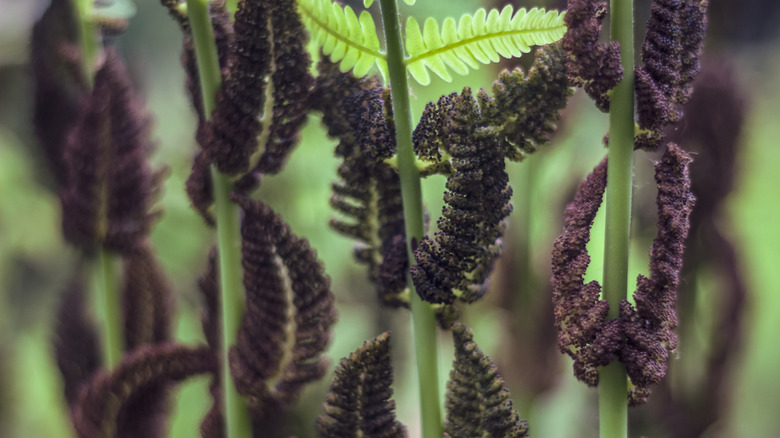The Best Native Fern For A Shady Ground Cover That Looks Lush All Season
Ferns thrive in moist, well-drained soil, and while some prefer full sun, most require a shady spot. As a ground cover, their lush, airy fronds provide an inviting green oasis. Even a dreary winter landscape can be brightened by some varieties of fern. Interrupted fern (Osmunda claytoniana), a native herbaceous perennial, is among the ferns classified as hardy, meaning they tolerate cold weather and can be grown year-round in warmer areas. Alone as a specimen planting or mixed with other plants that grow well in shady areas, interrupted ferns are attention grabbers. They get their odd common name from the spaces that appear between leaves on the fronds when leaflets drop off in mid-summer.
Interrupted ferns are among the tallest varieties of this plant type, reaching 2 to 5 feet tall, and are one of the easiest to grow. Hardy in USDA zones 3 through 8, Osmunda claytoniana is relatively pest-free and is unattractive to deer and rabbits. The fern appears early in the spring and spreads by rhizomes, which are horizontal roots growing underground. They grow in clumps and their vase shape spreads 2 to 4 feet wide as they mature. Be aware that it's normal for the center of this broadleaf evergreen to die back while the lower fronds continue to grow. Interrupted ferns reproduce by the spores contained in the little brown dots — spore cases — on the undersides of the leaves.
Growing interrupted ferns in a shade garden
Interrupted ferns can thrive in many light conditions, including dappled shade, where the sun is filtered through leaves, deep shade with no sun or less than two hours of sunlight a day, or partial shade, where the plants get direct sunlight for two to six hours a day. They're equally tolerant of different moisture conditions, surviving in standing water, moist soil, or occasionally wet earth. Interrupted ferns can even adapt to dry conditions.
Prepare your garden bed by working organic material into the top four to six inches of soil and testing the pH — interrupted ferns prefer acidic soil. While it's possible to grow your own ferns from spores, it's easier to buy ready-to-plant ferns at the nursery or propagate new plants through rhizome division. The time of the year you plant the ferns depends on the severity of your winters. The roots of young ferns planted in the fall suffer in harsh winters, so if it's going to be cold and wet before the plants establish themselves, plant in the spring. If your winters are mild, plant ferns in the fall.
Space the ferns in your garden around two feet apart and spread about two inches of shredded leaves or pine straw mulch around the plants to help maintain moisture and to protect the croziers or fiddleheads, the coiled structures at the base of the plant that form new fronds. Provide an inch or more of water a week in dry conditions. You can measure the amount of water by placing a dish or empty can in the garden and irrigating until an inch of water has accumulated in the dish; apply an organic fertilizer in the spring.

